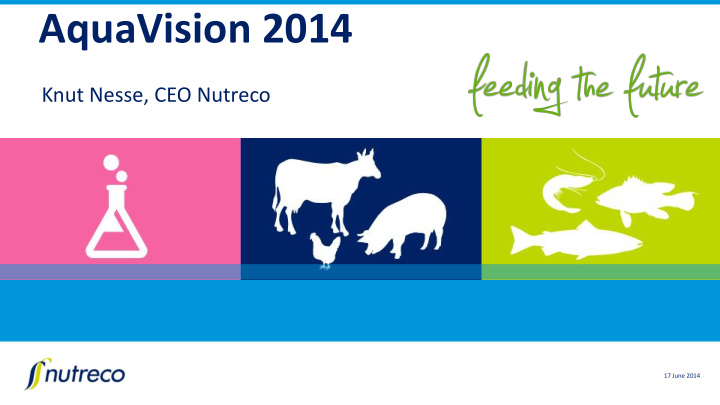



AquaVision 2014 Knut Nesse, CEO Nutreco 17 June 2014
Welcome to SPONSORED BY: INITIATED & ORGANISED BY:
17 th 10 7 1996 5,750 AgriVision Conference First Participants AquaVision conferences in 19 years AquaVision conferences
Our challenge Doubling the Halving the Feeding food production pressure on 9 billion people the planet in 2050
Our values Innovative
The essential link Surging demand Struggling supplies Farmers Raw material markets Animal nutrition & fish feed producers
Our strategy – Driving sustainable growth Higher Premix, feed Growth Sustainability value-added specialties geographies throughout and fish feed portfolio of Latin America, the feed-to- food chain nutritional Russia, Asia solutions and Africa
Nutreco’s three segments Revenue 2013: € 5.2 billion EBITA* 2013: € 256 million € 1.8 billion € 112 million Animal Nutrition € 131 million € 2.0 billion Fish Feed Iberia € 1.4 billion € 41 million Over 100 10 R&D units Multi national production plants in 7 countries workforce of in 30 countries 10,000 employees *Including corporate costs
Oceans of opportunities Est. 8.3bn Million tonnes 160 6.9bn 140 BRAZIL CHINA ECUADOR JAPAN 120 Aquaculture 100 EGYPT HONDURAS TURKEY VIETNAM 80 60 40 Wild capture for human consumption 20 Population Increased Health growth incomes 0 2010 2030 Aquaculture growth factors Source: FAO Fish to 2030 Prospects for Fisheries and Aquaculture, 2013
Challenge #1: raw materials 1 Fish meal Algae meal Meat meal Grain meal Insect meal replacement 2 Fish oil GM vegetable Microalgae replacement material
Challenge #2: fish health ISA Sea lice EMS Moving towards a holistic preventive approach Genetic Epidemiology Biosecurity selection Integrated pest Treatments Vaccines management strategies Health / functional diets
Challenge #3: sustainable fish farming practices Best practice implementation & knowledge transfer in fish farming • Leveraging technology and knowledge developed for more advanced species to other species and geographies (e.g. farming technologies, biosecurity plans, growth models, technical support)
Who are the winners? Species which are growing rapidly and could exceed 1 million harvested tonnes by 2020 5. 3. 4. 1. 2. Atlantic White Amazon Asian Tilapia salmon shrimp species species
Salmon x million Harvest tonnes volumes 2010 1.6 2020 est. 2.8 CAGR 6% Source: FAO
Shrimp x million Harvest tonnes volumes 2010 4.1 2020 est. 6.5 CAGR 5% Source: FAO and Skretting
Tilapia x million Harvest tonnes volumes 2010 3.4 2020 est. 8.0 CAGR 9% Source: FAO
Amazon species (e.g. tambaqui/pacu, pirarucu) x million Harvest tonnes volumes 2010 0.2 2020 est. 1.0 CAGR 18% Sources: FAO and Skretting
Asian species (e.g. snakehead, Asian bass) x million Harvest tonnes volumes 2010 1.0 2020 est. 1.5 CAGR 4% Sources: Skretting
Aquaculture Healthy and sustainable protein production: • Our most efficient livestock production • Flexible use of feed ingredients enables the industry to become a net fish protein producer • Food with relatively low carbon footprint • Promoting the use of sustainable feed ingredients
Feeding 9 billion people Dr. James Anderson Advisor for Oceans, Fisheries and Aquaculture, The World Bank Aquaculture growth and potentials Jose Villalon Corporate Sustainability Director, Nutreco Setting the bar for food production Prof. Jorgen Randers Norwegian Business School 2052: A global forecast for the next forty years
The blue revolution Philippa Jones Harald Serck-Hanssen Managing Director, China Policy Vice President, DNB Bank ASA The blue revolution in China Financing the blue revolution Fred Formanek Prof. Stèphane Garelli Managing Partner, Advance Africa IMD and University of Lausanne Challenging the future - Aquaculture in Is better good enough? A competitiveness Africa and the West Indian Ocean region outlook for 2014 and beyond Sir Bob Geldof The biggest challenges in the world today can only be overcome when the big players find a way to work together strategically
Beyond tomorrow Krijn Rietveld Prof. David Robertson Wharton School Senior Vice-President Innovation, DSM Bringing innovation to the table Brick by brick: How LEGO rewrote the rules Trond Williksen Viggo Halseth Chief Executive Officer, AKVA Group Chief Innovation Officer, Nutreco Bringing technology to sustainable aquaculture Efficiency as driver for sustainable aquaculture Lars H. Stien Arne Hjeltnes Researcher, Institute of Marine Research Chief Executive Officer, Creuna Mismatching host and parasite depth Licence to operate through better reputation John Arne Breivik Steven Rafferty General Manager, Stingray Marine Solutions Managing Director, Skretting Technology for growth Closing remarks
Recommend
More recommend